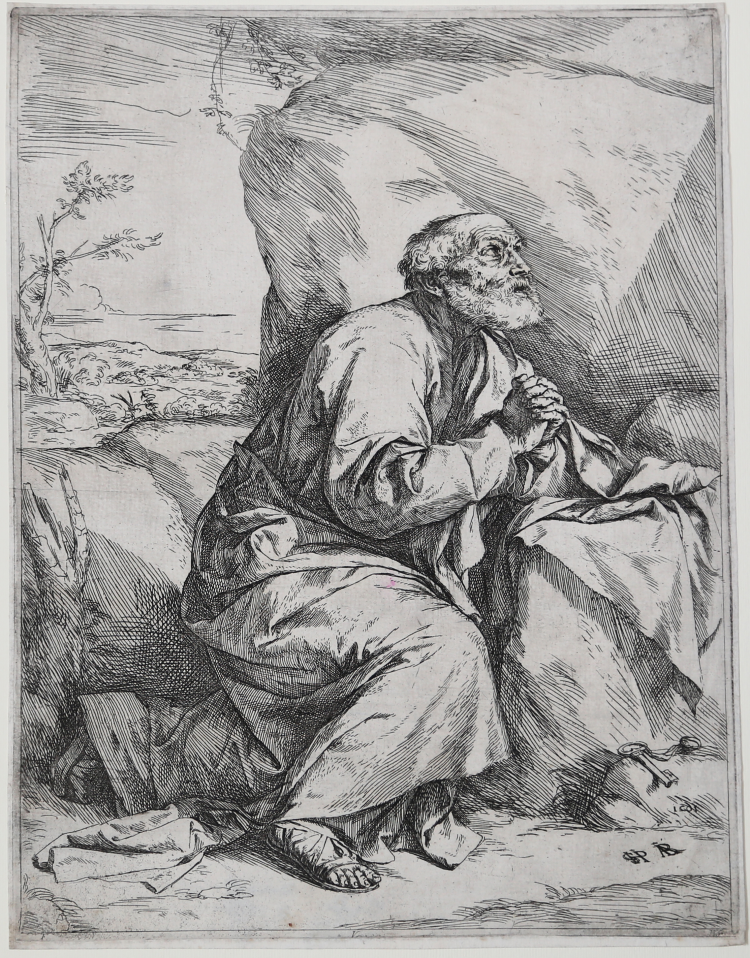




| Reference: | S39273 |
| Author | Jusepe di RIBERA detto "lo Spagnoletto" |
| Year: | 1620 ca. |
| Measures: | 245 x 327 mm |



| Reference: | S39273 |
| Author | Jusepe di RIBERA detto "lo Spagnoletto" |
| Year: | 1620 ca. |
| Measures: | 245 x 327 mm |
Etching with some engraving, signed with a monogram and dated 1621. Example in the second state, of two, with the letter “F, V, WYN” in basso (monogramma dell’editore Fransz van Wyngaerde).
Magnificent example printed on contemporary laid paper, thin margins, in excellent condition.
This etching bears the same date as the first composition of “Saint Jerome Hearing the Trumpet”, whereas its monogram is in the pointendly perspectival arrangement of the second. Like the dated Saint Jerome, the Saint Peter corresponds to one of the paintings by Ribera in the Colegiata of Osuna, for which there is also a related drawing n the same direction as the print (private collection, Paris). There are subtle variations between the Saint Peter images: above all, Ribera changed the disposition of the saint’s legs and the fall of his robe and offered two different landscape backgrounds. The print succeeded the painting in the date, suggesting again than the etchings were meant to disseminate knowledge of Ribera’s art, in this case one of his first great commissions in Naples, which significantly, was for the Spanish viceroy.
The portrayal of Saint Peter doing penance in the wild is one of a number of early subjects in which Ribera presents sacred figures casting off all wordly things. For the apostle, this act of renunciation occurred in response to Christ’s preaching the necessity of abandoning all possessions, to which Peter replied “Behold, we have forsaken all, and followed thee” (Matt. 19:27).
|
Pérez Sánchez – Spinosa (1992), n. 76; Bartsch, 7; Brown, 6; TIB 44.257.7; Salamon, n. 8; Bayer, 375.3.6.
|
Jusepe di RIBERA detto "lo Spagnoletto" (Jatiba circa 1590 - Napoli 1652)
|
Spanish painter and printmaker, active in Italy. He was one of the most important figures in European painting in the 17th century and one of the major artists of the Counter-Reformation. Though Spanish, he spent his entire career in Italy, and his evolution reflected developments in Italian art at that time. His first works show the influence of northern followers of Caravaggio active in Rome. He subsequently incorporated elements of Venetian art and, in his last works, combined all the sensual and colourist opulence of both Venice and Flanders, creating new and highly personal compositions.
|
|
Pérez Sánchez – Spinosa (1992), n. 76; Bartsch, 7; Brown, 6; TIB 44.257.7; Salamon, n. 8; Bayer, 375.3.6.
|
Jusepe di RIBERA detto "lo Spagnoletto" (Jatiba circa 1590 - Napoli 1652)
|
Spanish painter and printmaker, active in Italy. He was one of the most important figures in European painting in the 17th century and one of the major artists of the Counter-Reformation. Though Spanish, he spent his entire career in Italy, and his evolution reflected developments in Italian art at that time. His first works show the influence of northern followers of Caravaggio active in Rome. He subsequently incorporated elements of Venetian art and, in his last works, combined all the sensual and colourist opulence of both Venice and Flanders, creating new and highly personal compositions.
|